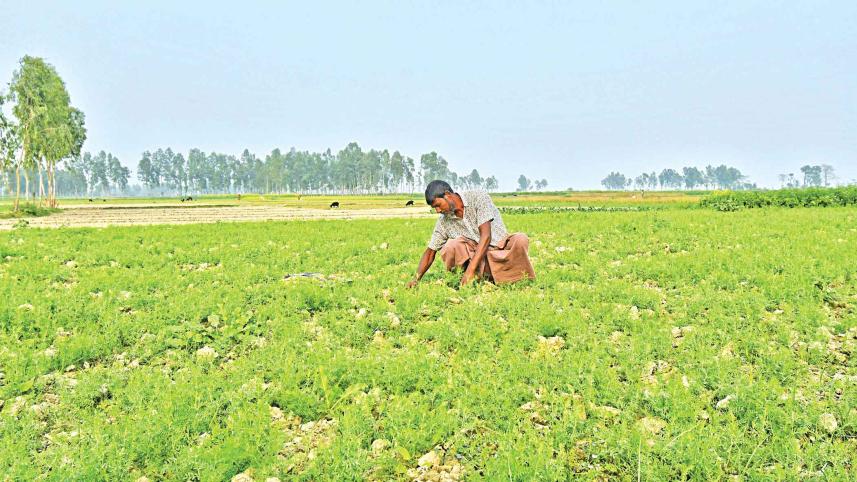Low profits pushing farmers away from legume cultivation

Farmers in various areas of the country are gradually shifting away from legumes in favour of other crops as lentils and pulses have become less profitable now.
Legume cultivation in four districts -- Bogura, Joypurhat, Pabna and Sirajganj -- decreased 19 per cent from nearly 60 lakh acres in fiscal 2016-17 to around 49 lakh acres in the current year, according to data from the Department of Agricultural Extension (DAE) office in Bogura.
The situation is similar at the national level as farmers grew various pulses and lentils on 10.11 lakh acres in 2014-15 while it was 8.75 lakh acres in 2018-19, data from the Bangladesh Bureau of Statistics shows.
Individually, lentil cultivation fell to 3.51 lakh acres in 2018-19, down 9 per cent year-on-year from 3.85 lakh, while the production of Indian peas dropped 7 per cent to hit 2.57 lakh tonnes over the same period.
Farmers say that they are no longer enthusiastic about growing lentils or pulses as the high-protein crop's low yield make it hard to turn a profit.
Besides, the crop's susceptibility to rain and cold is another reason for the farmers to lose interest.
"Lentil cultivation is not growing as other crops, mainly vegetables, are more profitable during winter," said Ohbiul Islam, a farmer of Salimpur village under Ishwardi upazila of Pabna, one of the biggest lentil producing districts in the north.
Farmers in other districts echoed the same.
"Lentil cultivation is less profitable than rice, chili, maize and wheat and so, I opted for other crops," said Zahidul Islam Pramanik, a farmer of Kuripara char under Bogura's Sariakandi upazila.
Pramanik makes nearly Tk 60,000 as profit from his one bigha chili plantation whereas lentil cultivation on the same area of land would bring him hardly around Tk 21,000.
Due to the crop's low profitability, most farmers grow legumes mainly for their own consumption or to use as animal feed.
And even though legumes are fairly easy to care for, other crops still hold more potential for the farmers.

For instance, Sagar Islam, a farmer of Pakhimara char under Sariakandi area, said he cultivated lentils on 1.5 bighas of infertile land in a char area.
But on three bighas of arable land Islam planted chilis.
"This is because I can get Tk 200,000 profit from chili cultivation on this land," he said.
Habizar Molla, a farmer of Dakatmara char of Bogura's Sariakandi upazila, said they used to cultivate lentils and other varieties of pulses in the char areas 15 to 20 years ago.
"But after getting the improved varieties of maize, rice, chili and wheat, many of us shifted to these crops for getting more profit," Molla added.
DAE Director General Md Asadullah said pulse cultivation is falling in the northern regions, including Dhaka and Mymensingh.
But on the other, it is expanding in the south, particularly in Barishal and Bhola districts.
"Pulses are a winter crop and it has to compete with other crops like mustard, maize, potato and rice as the amount of arable land is finite," Asadullah said, adding that low yields make it hard to profit from legumes.
However, the DAE is developing demonstration plots with some high-yield varieties to encourage farmers to produce legumes.
"We will train the growers on how to preserve seeds as well," he said.
When contacted, Debashish Sarker, director of the Pulses Research Centre of the Bangladesh Agricultural Research Institute in Pabna's Ishwardi upazila, said two varieties of lentils -- BARI lentil-8 and 9 -- are becoming popular among farmers.
If farmers can cultivate these two varieties, they can get 8-10 maunds (one maund equals 37 kilogrammes) of lentils per bigha.
They could then sell each maund of legume for Tk 24,000-30,000 at the current market prices.
Meanwhile, the BARI Kheshari-3 and 6 varieties are also gaining popularity, the DAE director general said.




 For all latest news, follow The Daily Star's Google News channel.
For all latest news, follow The Daily Star's Google News channel.
Comments